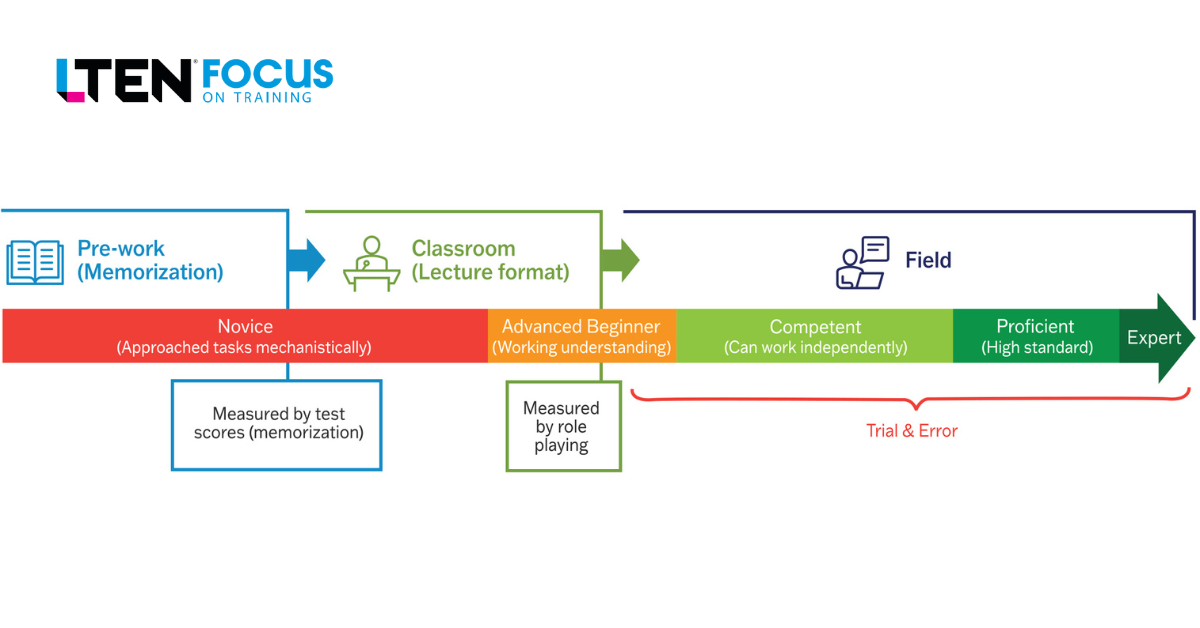
Sales Training – By Dr. Jim Guilkey
What can organizations do to improve sales?
Statistics indicate most sales training is neither effective nor efficient. According to Forbes magazine, 55% of salespeople lack basic sales skills. Another recent survey found that 64% of all sales training is lost after 90 days. And finally, 82% of B2B decision-makers think sales reps are unprepared.
So, what can organizations do to improve sales effectiveness? It starts with rethinking how you design, develop and deliver training to your salesforce.
Current Sales Training Model
Traditionally, sales training follows a predictable approach. Pre-work, classroom and field experience. The major issue is that this model focuses on memorization rather than application and relies heavily on learning on the job. Figure 1 illustrates the traditional sales training architecture.
The traditional sales training program is structured as follows:
Pre-work: Begins with pre-work, which is normally comprised of elearning “page-turners” that promote memorization of specified content. Comprehension is measured using multiple-choice exams and pre-established “passing” scores (e.g., 85%).
Classroom: Pre-work is followed by classroom sessions conducted by subject matter experts (SMEs) utilizing a didactic lecture format. SMEs are critical to developing effective training but may have little, if any, knowledge related to designing and delivering effective learning. Again, comprehension is measured by “tests” that may be combined with some basic role-playing exercises.
Field: Finally, the learner is put into the field. The field experience relies heavily on “trial-and error” and may be supported by intermittent “coaching” from an experienced sales associate. The fact that learners have memorized information and passed a set of designated tests does not actually prepare them for success in the field. As a matter of fact, it can create several problems.
The Dreyfus Model of Skill Acquisition
The Dreyfus model describes how individuals progress through various levels in their acquisition of skills and includes ideas regarding how individuals learn. When you overlay the Dreyfus stages of expertise onto the traditional sales training architecture, it indicates that the traditional model produces a learner who has only achieved the advanced beginner stage prior to entering the field.
As stated, further learning is heavily reliant upon trial and error. This trial-and-error approach has several disadvantages:
- Damaged relationships: During initial sales calls in the field, the lack of knowledge and expertise of the advanced beginner may result in damaging relationships with potential clients. This is especially true in the medical industry, where physicians are short on both time and patience. They require that sales associates add value and have limited tolerance for incompetence. An advanced beginner is not prepared to fully answer questions, utilize data and meet the needs of their customers.
- Lost sales and revenue: The fact that sales associates enter the field as only advanced beginners can result in lost sales and associated revenue. Extensive knowledge and expertise are foundational to successful medical sales, and allowing associates into the field without them can have adverse effects. A lost sale due to inadequate knowledge and skills may not only lose the current sale, but subsequent opportunities in the future. (See Figure 1.)
- Frustration and turnover: Entering the field as advanced beginners can have negative effects on the sales associates themselves. Lack of success can create frustration and, eventually, employee turnover.
Designing for Highly Effective Sales Training
There are four major design canons that should be incorporated to ensure highly effective sales training. The design must be:
- Problem-based: Give learners problems to solve, the content needed to solve the problem and the ability to collaborate. Problem-based learning results in higher levels of learning (e.g., application and correlation vs. rote memorization of facts to be tested in a multiple-choice exam).
- Learner-focused: Put the impetus and responsibility on the learner rather than always relying on a facilitator or coach. Example: Provide learners with a scenario/problem (e.g., overcoming an objection), the associated information and data needed, and have them work together to address the scenario. In addition, provide learners with tools to address the situation. These tools will not only enhance learning but will be used in the field to develop expertise more quickly.
- Collaborative: Allow learners to collaborate on problem-solving and various other learning activities. Collaboration can occur with other learners as well as experts, etc. Collaboration can be real-time (e.g., virtual classroom) or simulated (e.g., have learners review how an expert reacted to a problem and utilize that knowledge in their problem-solving activity). Collaboration enhances learning by requiring learners to apply knowledge rather than simply memorizing information, scripts and so forth.
- Application-centric: Unlike traditional sales training, which focuses on memorization and testing, truly effective design focuses on application of learning. When learners are exposed to training centered on application not memorization, they are prepared to immediately apply their knowledge and skills in the field. They have already achieved Dreyfus’s competent stage and can rapidly advance to the proficient and expert stages. (See Figure 2.) Highly effective design for sales training is structured as follows:
- Pre-work: A blend of various learning assets, including micro-mods, group activities and performance-support tools. The major difference is that all learning requires “application” of knowledge and skills to evaluate comprehension and assimilation, not simply multiple-choice testing. Testing can be utilized for certain foundations (e.g., anatomy) but the majority of learning requires application. Overcoming objections (example): Use micro-modules to provide foundational knowledge. Within the modules, have learners review various videos (e.g., sales rep discussing with physician) related to overcoming objections and then have them evaluate those interactions based on a set of established criteria (e.g., did the rep ask for clarification?). Provide a performance support tool that assists with the evaluation (e.g., defining criteria for high and low scores). This tool can then be used in future exercises as well as once the learners enter the field.
- Interactive classroom: Classroom activities should not focus on a lecture format. They need to incorporate problem-based activities that utilize collaboration.
Overcoming objections (example): Provide the learners with a scenario (e.g., physician’s objection to the use of a certain drug). Ask them to work in groups to create a presentation that addresses the objection. Provide them with content (statistics, data, physician personality profile, etc.) needed to address the objection.
Also, provide the groups with a tool to help structure the presentation. This tool can again be used once they’re back in the field. While one group presents, have the other groups evaluate that presentation. This is problem-based learning at its best, where the facilitator becomes a guide and collaborator rather than a classroom lecturer. - Performance-support tools: Tools that allow users to both learn and then utilize in the field (e.g., pre-call planning guide). The key is to introduce the tools early in the training and utilize them throughout the program. This will enhance learning and increase usage and sustainability in the field.
- Structured field experiences: Traditionally, new sales associates do “ride-a-longs” in the hope that some learning will transfer from an experienced rep to the new hire. This approach is not highly effective. Instead, structure those field experiences with specific learning objectives in mind. Begin with simple activities that become increasingly more complex. The impetus for learning is on the new hire, not the experienced rep. Again, providing performance support tools for the structured field experiences(many of which have already been utilized throughout training) will enhance both the experience and level of learning.
Summary
As the statistics demonstrated earlier, traditional sales training is ineffective and inefficient. Relying on trial and error in the field to gain expertise can have adverse effects.
By utilizing effective design methodologies and constantly requiring application of knowledge and skills throughout the program, the sales associate will enter the field at a much higher level of competency and will rapidly develop expertise. This will greatly enhance revenue, motivation and ultimate success.
 Jim Guilkey is president of S4 NetQuest. Email Jim at jguilkey@s4netquest.com.
Jim Guilkey is president of S4 NetQuest. Email Jim at jguilkey@s4netquest.com.










